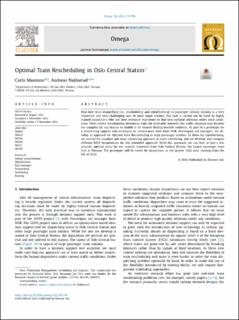| dc.contributor.author | Mannino, Carlo | |
| dc.contributor.author | Nakkerud, Andreas | |
| dc.date.accessioned | 2023-02-23T12:13:55Z | |
| dc.date.available | 2023-02-23T12:13:55Z | |
| dc.date.created | 2022-12-06T13:43:46Z | |
| dc.date.issued | 2022 | |
| dc.identifier.citation | Omega. The International Journal of Management Science. 2022, 116, 102796. | en_US |
| dc.identifier.issn | 0305-0483 | |
| dc.identifier.uri | https://hdl.handle.net/11250/3053591 | |
| dc.description.abstract | Real-time train dispatching (i.e., rescheduling and replatforming) in passenger railway stations is a very important and very challenging task. In most major stations, this task is carried out by hand by highly trained dispatchers who use their extensive experience to find near-optimal solutions under most conditions. With several simultaneous deviations from the timetable, however, the traffic situation may become too complex for any human to handle it far beyond finding feasible solutions. As part of a prototype for a dispatching support tool developed in collaboration with Bane NOR (Norwegian rail manager), we develop an approach for Optimal Train Rescheduling in large passenger stations. To allow for replatforming, we extend the standard job-shop scheduling approach to train-scheduling, and we develop and compare different MILP formulations for this extended approach. With this approach, we can find, in just a few seconds, optimal plans for our realistic instances from Oslo Central Station, the largest passenger train hub in Norway. The prototype will be tested by dispatchers in the greater Oslo area, starting from the fall of 2021. | en_US |
| dc.language.iso | eng | en_US |
| dc.publisher | Elsevier | en_US |
| dc.rights | Navngivelse 4.0 Internasjonal | * |
| dc.rights.uri | http://creativecommons.org/licenses/by/4.0/deed.no | * |
| dc.subject | Schedulering | en_US |
| dc.subject | Scheduling | en_US |
| dc.subject | Optimalisering | en_US |
| dc.subject | Optimization | en_US |
| dc.title | Optimal Train Rescheduling in Oslo Central Station | en_US |
| dc.title.alternative | Optimal Train Rescheduling in Oslo Central Station | en_US |
| dc.type | Peer reviewed | en_US |
| dc.type | Journal article | en_US |
| dc.description.version | publishedVersion | en_US |
| dc.rights.holder | © 2022 The Authors | en_US |
| dc.subject.nsi | VDP::Matematikk: 410 | en_US |
| dc.subject.nsi | VDP::Mathematics: 410 | en_US |
| dc.subject.nsi | VDP::Matematikk: 410 | en_US |
| dc.subject.nsi | VDP::Mathematics: 410 | en_US |
| dc.source.pagenumber | 15 | en_US |
| dc.source.volume | 116 | en_US |
| dc.source.journal | Omega. The International Journal of Management Science | en_US |
| dc.identifier.doi | 10.1016/j.omega.2022.102796 | |
| dc.identifier.cristin | 2089445 | |
| dc.relation.project | Norges forskningsråd: 300509 | en_US |
| dc.relation.project | Norges forskningsråd: 237718 | en_US |
| dc.relation.project | Norges forskningsråd: 267554 | en_US |
| dc.source.articlenumber | 102796 | en_US |
| cristin.ispublished | true | |
| cristin.fulltext | original | |
| cristin.qualitycode | 2 | |

